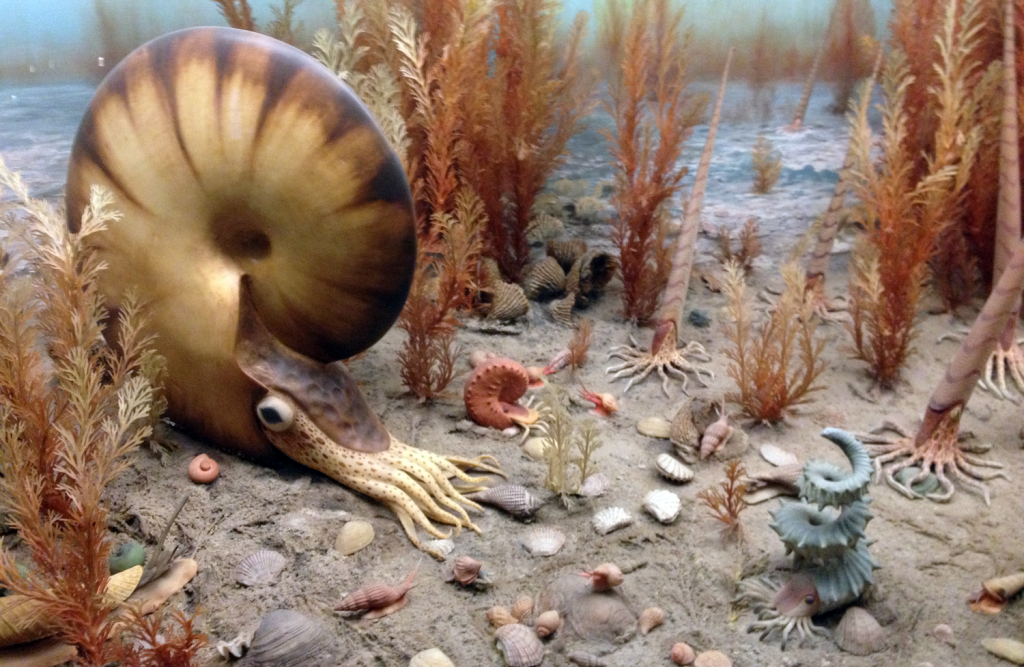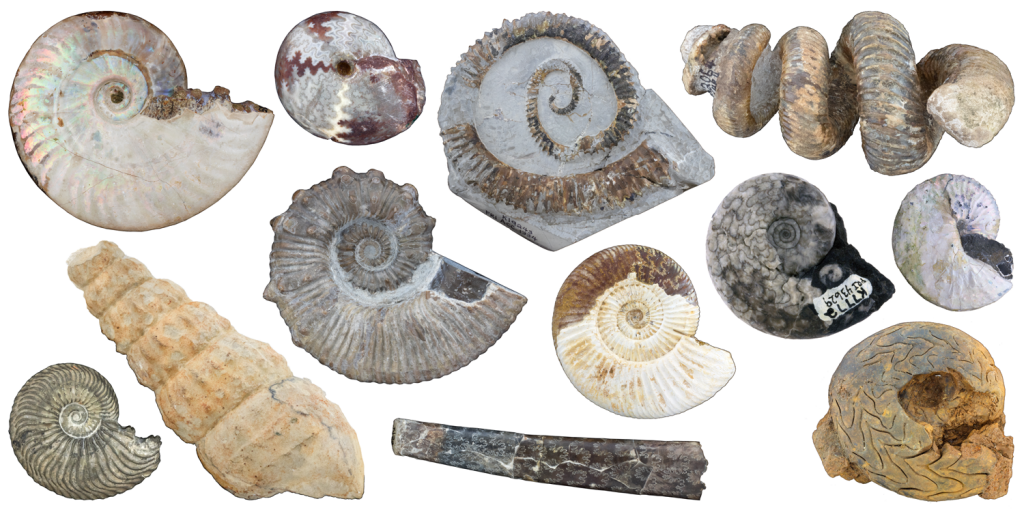Ammonoidea Review
Ammonoid fossils are fascinating relics of ancient marine life, offering a glimpse into the diverse and intriguing world of these extinct cephalopods. Here’s a review of Ammonoidea fossils:
- Diversity: Ammonoids exhibited incredible diversity in size, shape, and ornamentation. Their shells ranged from tiny, thumbnail-sized specimens to large, intricately coiled forms spanning several feet in diameter.
- Fossil Record: These fossils are abundant and found worldwide in various sedimentary rock formations, making them crucial for stratigraphic studies. Their rapid evolutionary changes and distinct morphological features make them valuable index fossils, aiding in dating rock layers.
- Scientific Significance: Ammonoid fossils contribute significantly to our understanding of ancient marine ecosystems, evolution, and paleobiology. Their well-preserved shells provide insight into their chambered anatomy and growth patterns.
- Collector’s Appeal: Ammonoid fossils are highly sought after by collectors and enthusiasts due to their aesthetic beauty and intricate shell patterns. They are often used in jewelry, displayed in collections, or studied by amateur and professional paleontologists alike.
- Symbolism and Cultural Significance: Throughout history, ammonoids have held symbolic importance in various cultures, representing different concepts such as change, balance, and the cycles of life.
- Extinction and Research: The mass extinction event at the end of the Cretaceous period wiped out ammonoids along with many other species. Scientists study their fossils to understand the factors leading to their extinction and the broader impact on marine life.
In summary, Ammonoidea fossils are not only visually captivating but also hold immense scientific value. Their study aids in unraveling the mysteries of prehistoric oceans, contributing to our knowledge of Earth’s history and evolution. Whether for scientific research, aesthetic appreciation, or symbolic significance, ammonoid fossils remain an essential and intriguing aspect of paleontology and natural history.

Are ammonite fossils worth money?
The value of an ammonite fossil can vary significantly based on several factors:
- Size and Condition: Larger, well-preserved specimens tend to command higher prices compared to smaller or damaged fossils.
- Rarity and Species: Certain species or rare variations of ammonites can be more valuable due to their scarcity or unique characteristics.
- Aesthetic Appeal: Fossils with striking patterns, exceptional preservation, or unique colors may be more sought after by collectors, potentially increasing their value.
- Provenance and Authenticity: Fossils with well-documented provenance and verified authenticity tend to have higher value as they assure buyers of their legitimacy.
- Market Demand: Fluctuations in the market and the demand for certain types of fossils can impact their value. Trends in collecting and scientific interest also influence prices.
While some ammonite fossils can be relatively affordable, rare or exceptionally well-preserved specimens can fetch high prices at auctions or from specialized fossil dealers. Prices can range from a few dollars for small, common specimens to thousands of dollars or more for large, rare, or exceptionally well-preserved examples.
If you’re considering purchasing or selling an ammonite fossil, it’s essential to research and assess the fossil’s quality, rarity, and market demand to determine its potential value. Additionally, consulting with reputable fossil dealers or appraisers can provide valuable insights into the specific worth of an ammonite fossil.
Are ammonites index fossils?
Yes, ammonites are considered excellent index fossils due to several factors:
- Abundance: Ammonite fossils are widespread and found in various sedimentary rock layers around the world. Their abundance allows for easy identification and correlation between different geological formations.
- Rapid Evolution: Ammonites had a relatively short lifespan and evolved rapidly. Their distinct morphological changes over time create well-defined and recognizable fossil species, aiding in dating rock layers.
- Wide Distribution: Different species of ammonites existed during specific time periods. As such, the presence of certain ammonite species in a particular rock layer can indicate the approximate age of that layer.
- Stratigraphic Zonation: By studying the succession of ammonite species in rock layers, geologists can create biozones or biostratigraphic units that help in establishing relative geological time scales.
Due to these characteristics, ammonites are valuable for stratigraphic studies. Geologists use them as guide fossils to date and correlate rock layers, allowing for the relative dating of geological formations based on the presence and succession of specific ammonite species within those formations.

What are ammonite fossils good for?
Ammonite fossils serve various purposes and hold significance in several fields:
- Paleontology and Evolutionary Studies: Ammonite fossils provide valuable insights into the evolutionary history, diversity, and paleobiology of these extinct cephalopods. They help scientists understand ancient marine ecosystems, behavior, and adaptation.
- Stratigraphy and Geological Dating: Ammonites are excellent index fossils used by geologists for stratigraphic correlation and dating of rock layers. Their rapid evolution and wide distribution make them crucial for establishing relative geological timelines.
- Education and Research: These fossils are essential in educational settings, allowing students and researchers to study ancient marine life, fossilization processes, and geological history. They aid in understanding Earth’s past and the interconnectedness of life forms.
- Collector’s Items and Aesthetic Value: Ammonite fossils are highly prized by collectors and enthusiasts for their aesthetic beauty, intricate shell patterns, and unique shapes. They are often displayed in collections, museums, and used in jewelry or decorative pieces.
- Cultural and Symbolic Significance: Throughout history, ammonites have held symbolic significance in various cultures, representing concepts like change, transformation, and the cyclical nature of life. They feature in art, literature, and spiritual beliefs.
- Scientific Understanding of Extinction Events: Studying the extinction of ammonites at the end of the Cretaceous period provides insights into mass extinctions and their impact on ecosystems, aiding in understanding modern extinction events.
Overall, ammonite fossils serve as windows into Earth’s ancient past, offering a wealth of information for scientific study, educational purposes, and appreciation of natural history and aesthetics.
How much is an ammonite fossil worth?
The value of an ammonite fossil can vary widely based on several factors:
- Size and Condition: Larger, well-preserved specimens tend to be more valuable than smaller or damaged fossils.
- Rarity and Species: Some species or rare variations of ammonites can fetch higher prices due to their scarcity or unique characteristics.
- Aesthetic Appeal: Fossils with striking patterns, exceptional preservation, or unique colors may be more sought after by collectors, potentially increasing their value.
- Provenance and Authenticity: Fossils with well-documented provenance and verified authenticity tend to have higher value as they assure buyers of their legitimacy.
- Market Demand: Fluctuations in the market and the demand for certain types of fossils can impact their value. Trends in collecting and scientific interest also influence prices.
Prices for ammonite fossils can range widely. Small, common specimens might be relatively affordable, priced in the tens to hundreds of dollars, while larger, rare, or exceptionally well-preserved examples can fetch thousands of dollars or more at auctions or from specialized fossil dealers.
If you’re looking to buy or sell an ammonite fossil, it’s essential to research and assess the fossil’s quality, rarity, and market demand. Consulting with reputable fossil dealers or appraisers can provide insights into the specific value of an ammonite fossil in today’s market.

Are ammonite fossils faked?
Yes, like many valuable fossils, ammonite fossils can be faked or altered. Here are a few ways in which ammonite fossils might be misrepresented:
- Composite Fossils: Sometimes, individuals create composite fossils by combining real parts of ammonite fossils with fabricated or reconstructed sections. This can artificially enhance the appearance or size of the fossil.
- Artificial Coloring: Fossils might be artificially colored or enhanced to make them more visually appealing or to create patterns that don’t exist naturally.
- Replicas and Forgeries: Some individuals create replicas or forgeries of ammonite fossils using materials like resin or plaster. These replicas might be sold as genuine fossils, deceiving buyers.
- Reconstruction of Broken Fossils: Occasionally, broken ammonite fossils are repaired or reconstructed using artificial materials, making them appear more complete than they actually are.
To ensure the authenticity of an ammonite fossil, it’s essential to buy from reputable dealers, preferably those who provide documentation or provenance for their fossils. Additionally, examining the fossil closely for inconsistencies, unnatural coloring, or signs of fabrication can help in detecting potential fakes. Seeking the expertise of professional appraisers or paleontologists can also assist in verifying the authenticity of an ammonite fossil before making a purchase.
How can you tell if an ammonite fossil is real?
Authenticating an ammonite fossil requires a keen eye and attention to detail. Here are some methods to help determine if an ammonite fossil is real:
- Texture and Detail: Real ammonite fossils typically exhibit natural textures and details. Look for intricate patterns, ridges, and sutures (the lines where shell chambers meet). Genuine fossils often show signs of wear, erosion, or natural imperfections.
- Material and Weight: Fossils are often heavier than artificial replicas or fakes. Real ammonite fossils are made of mineralized material and tend to have a substantial weight compared to lighter, artificial materials like resin.
- Consistency in Pattern: Examine the entire surface of the fossil for consistency in the pattern. Replicas or fakes might show repetitive or identical patterns that appear unnatural.
- Authenticity Markers: Authentic fossils may show signs of the fossilization process, such as mineral deposits, small cracks, or other natural markings. These features contribute to their authenticity.
- Provenance and Documentation: Fossils with documented provenance or accompanied by reputable certificates of authenticity are more likely to be genuine. Verify the seller’s reputation and ask for any available documentation.
- Professional Authentication: Seek the expertise of a professional paleontologist or a reputable appraiser who specializes in fossils. They can conduct more in-depth examinations using specialized tools and knowledge.
- Price and Source: Be cautious if the price seems unusually low for the type or size of the fossil. Verify the source and reputation of the seller or dealer before making a purchase.
By combining these methods and seeking expert opinion when in doubt, you can increase the likelihood of determining the authenticity of an ammonite fossil.

How old is my ammonite fossil?
Determining the age of an ammonite fossil involves understanding the geological context in which it was found. Ammonites existed from the Devonian period to the end of the Cretaceous period, spanning approximately 350 million years. To estimate the age of your fossil:
- Geological Context: If you know where the fossil was found, research the geological formation or locality. Ammonites existed during specific geological periods, so understanding the age of the rock formation where the fossil was discovered can provide a general time frame.
- Index Fossils: Ammonites are excellent index fossils due to their rapid evolution and distinctive species. Different species lived during specific time periods, allowing geologists to use them as markers for dating rock layers. Matching the species of your ammonite with known index fossils can help estimate its age.
- Carbon Dating (if applicable): In some cases, if the fossil contains organic material, carbon dating techniques might be used to estimate its age. However, this method is generally more applicable to much younger fossils (up to about 50,000 years).
- Consult Experts: Seeking the advice of paleontologists or geologists who specialize in the study of ammonites can provide more accurate estimations of the fossil’s age based on its characteristics and the geological context.
Without specific details about the fossil’s location or species, providing an exact age might be challenging. However, understanding the geological context and the species of the ammonite can offer a good estimation of its age within the broader timeline of the ammonite’s existence.
What is the lifespan of an ammonite?
The lifespan of an individual ammonite varied based on species and environmental factors. Ammonites, like modern cephalopods (such as squids and octopuses), are thought to have had relatively short lifespans.
While it’s challenging to determine the exact lifespan of an ammonite due to their extinction millions of years ago, scientists estimate their lifespan by studying growth patterns preserved in their shells. By analyzing the growth lines or chambers within the shell, scientists can approximate the age of an individual specimen.
Generally, ammonites are believed to have had lifespans ranging from several months to a few years. Their rapid growth rates and short lifespans allowed them to reach maturity quickly and reproduce within their relatively brief lives.
Factors such as species, environmental conditions, predation, and available food sources likely influenced the lifespan of individual ammonites. However, their overall life expectancy fell within a relatively short timeframe compared to many other organisms.



